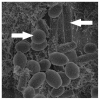Assessment of the types of catheter infectivity caused by Candida species and their biofilm formation. First study in an intensive care unit in Algeria
- PMID: 23345986
- PMCID: PMC3549679
- DOI: 10.2147/IJGM.S38065
Assessment of the types of catheter infectivity caused by Candida species and their biofilm formation. First study in an intensive care unit in Algeria
Abstract
Nosocomial candidiasis remains a potential risk in intensive care units (ICUs), wherein Candida albicans is most responsible for its occurrence. Equally, non-C. albicans species, especially C. glabrata, are also involved. These infections are frequently associated with biofilms that contaminate medical devices, such as catheters. These biofilms constitute a significant clinical problem, and cause therapeutic failures, because they can escape the immune response and considerably decrease sensitivity to antifungal therapy. The diagnosis of catheter-related candidiasis is difficult; however, the differentiation between an infection of the catheter (or other medical implant) and a simple contamination is essential to start an antifungal treatment. Among the methods used for this type of study is the Brun-Buisson method, but this method only examines the infectivity of catheters caused by bacteria. For this reason, we wanted to adapt this method to the yeast cells of Candida spp. To assess the various types of infectivity of catheters (contamination, colonization, or infection) and their corresponding rates, as well as the responsible yeast species, we conducted our study, between February 2011 and January 2012, in the ICU at the University Hospital Center of Sidi Bel Abbes, Algeria; during this study, we took photographic images of the tongue of one patient and of that patient's implanted orobronchial catheter. In addition, catheters contaminated by C. albicans biofilms were observed by scanning electron microscopy.
Keywords: ICU; colonization; contamination; infection.
Figures





Similar articles
-
Interaction in a dual-species biofilm of Candida albicans and Candida glabrata co-isolated from intravascular catheter.Microb Pathog. 2021 Mar;152:104613. doi: 10.1016/j.micpath.2020.104613. Epub 2020 Nov 20. Microb Pathog. 2021. PMID: 33227365
-
[Evaluation of mixed biofilm formation between Candida albicans and a variety of bacterial species isolated from peripheral catheters at Tlemcen CHU. First study in Algeria].J Mycol Med. 2015 Jun;25(2):123-9. doi: 10.1016/j.mycmed.2015.03.001. Epub 2015 May 6. J Mycol Med. 2015. PMID: 25957712 French.
-
[Investigation of the correlation between biofilm forming ability of urinary Candida isolates with the use of urinary catheters and change of antifungal susceptibility in the presence of biofilm].Mikrobiyol Bul. 2016 Apr;50(2):256-65. doi: 10.5578/mb.24248. Mikrobiyol Bul. 2016. PMID: 27175498 Turkish.
-
Candida and candidaemia. Susceptibility and epidemiology.Dan Med J. 2013 Nov;60(11):B4698. Dan Med J. 2013. PMID: 24192246 Review.
-
Echinocandins: Their role in the management of Candida biofilms.Indian J Med Microbiol. 2018 Jan-Mar;36(1):87-92. doi: 10.4103/ijmm.IJMM_17_400. Indian J Med Microbiol. 2018. PMID: 29735833 Review.
Cited by
-
Implications of the presence of yeasts in tracheobronchial secretions of critically ill intubated patients.EXCLI J. 2019 Sep 9;18:801-811. doi: 10.17179/excli2019-1631. eCollection 2019. EXCLI J. 2019. PMID: 31645841 Free PMC article.
-
An 11-Year retrospective analysis of candidiasis epidemiology, risk factors, and antifungal susceptibility in a tertiary care hospital in China.Sci Rep. 2025 Feb 28;15(1):7240. doi: 10.1038/s41598-025-92100-x. Sci Rep. 2025. PMID: 40021727 Free PMC article.
-
An expanded regulatory network temporally controls Candida albicans biofilm formation.Mol Microbiol. 2015 Jun;96(6):1226-39. doi: 10.1111/mmi.13002. Epub 2015 Apr 23. Mol Microbiol. 2015. PMID: 25784162 Free PMC article.
-
Regulation of candidalysin underlies Candida albicans persistence in intravascular catheters by modulating NETosis.PLoS Pathog. 2024 Jun 17;20(6):e1012319. doi: 10.1371/journal.ppat.1012319. eCollection 2024 Jun. PLoS Pathog. 2024. PMID: 38885290 Free PMC article.
-
Antibiofilm and Antihyphal Activities of Cedar Leaf Essential Oil, Camphor, and Fenchone Derivatives against Candida albicans.Front Microbiol. 2017 Aug 3;8:1476. doi: 10.3389/fmicb.2017.01476. eCollection 2017. Front Microbiol. 2017. PMID: 28824600 Free PMC article.
References
-
- Vandijck D, Blot S, Labeau S, et al. Candidemia in critically ill patients: An analysis of daily antifungal therapy related costs. J Mycol Med. 2008;18(2):96–99.
-
- Falagas ME, Roussos N, Vardakas KZ. Relative frequency of albicans and the various non-albicans Candida spp among candidemia isolates from inpatients in various parts of the world: a systematic review. Int J Infect Dis. 2010;14(11):e954–e966. - PubMed
-
- Eloy O, Marque S, Mourvilliers B, et al. Contribution of the Pittet’s index, antigen assay, IgM, and total antibodies in the diagnosis of invasive candidiasis in intensive care unit. J Mycol Med. 2006;16(3):113–118.
-
- Eggimann P, Pittet D. Candidoses en réanimation. [Candidiasis in the ICU]. Réanimation. 2002;11:209–221. French.
-
- Seabra R, Bhogal N. Hospital infections, animal models and alternatives. Eur J Clin Microbiol Infect Dis. 2009;28(6):561–568. - PubMed
LinkOut - more resources
Full Text Sources
Other Literature Sources
Miscellaneous

